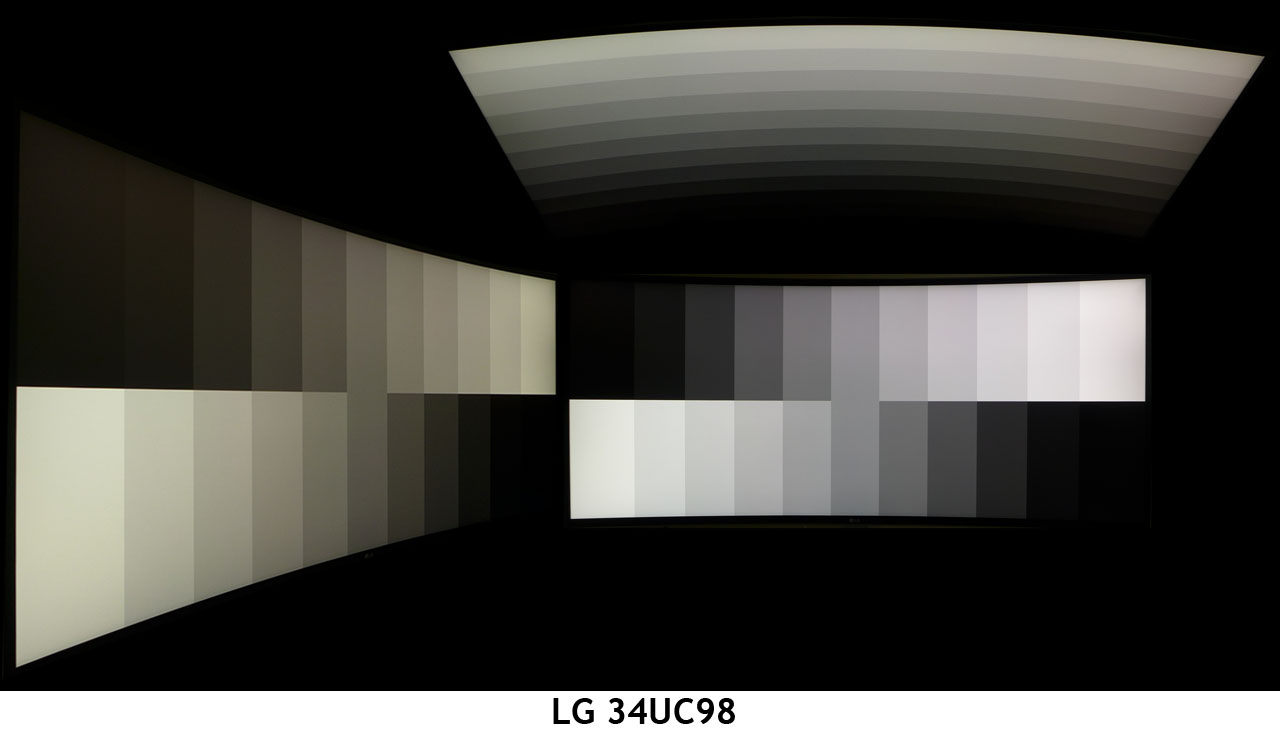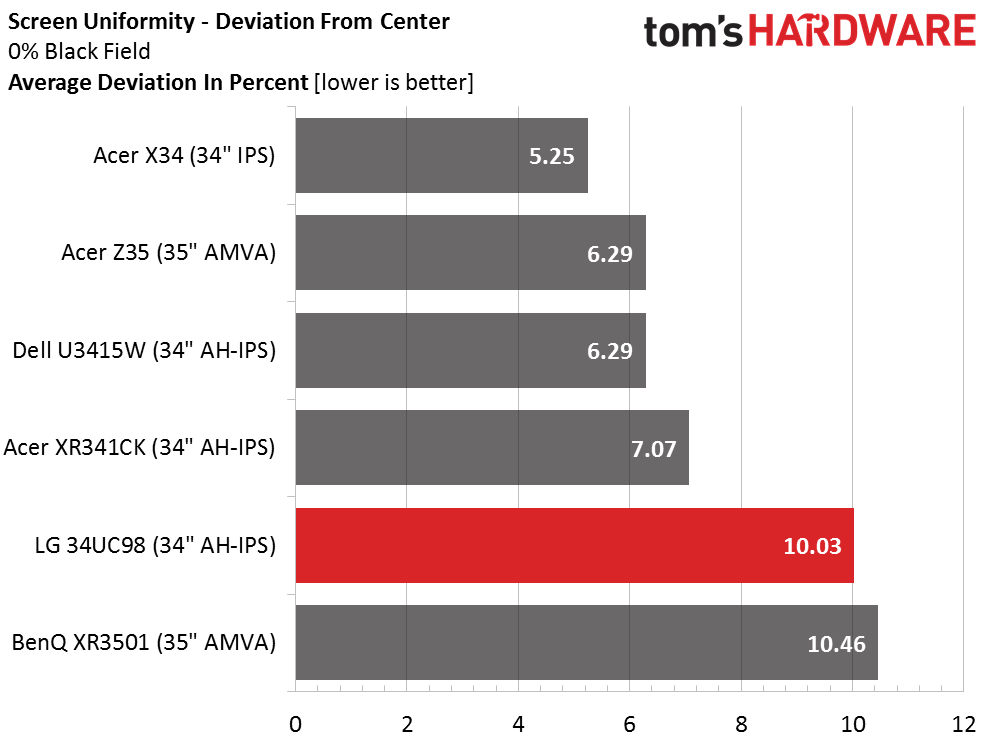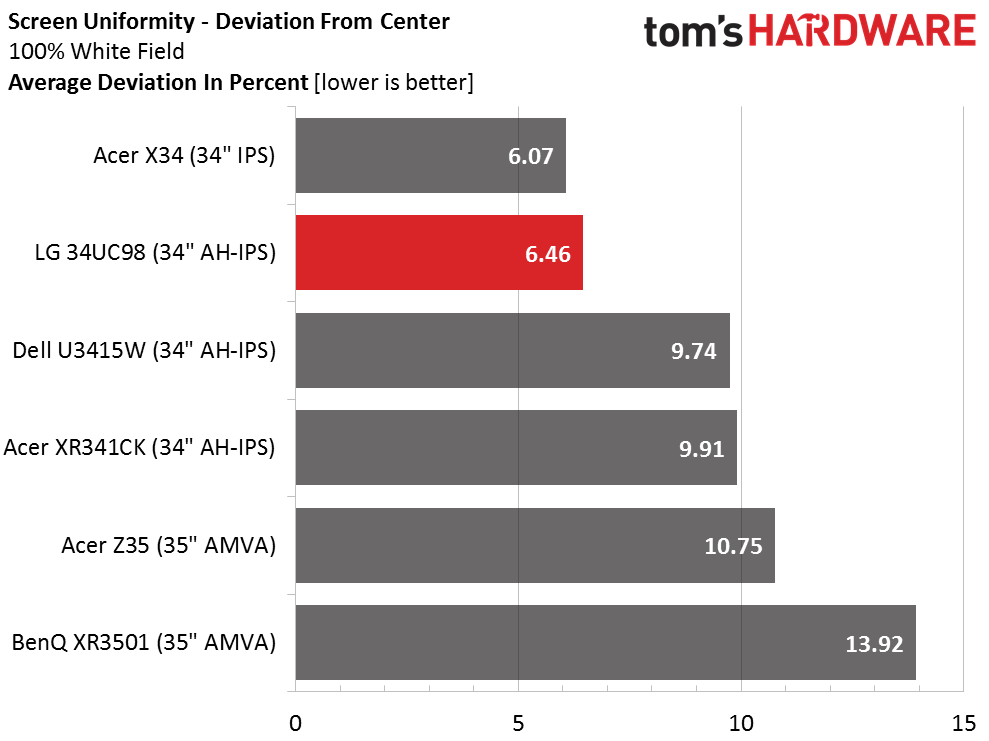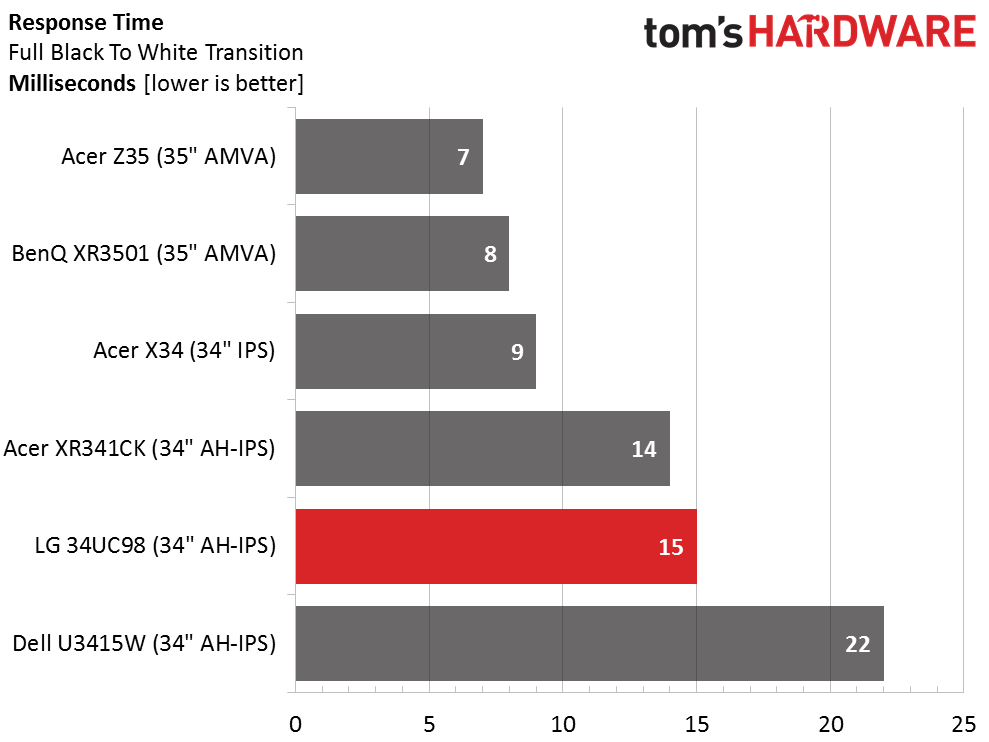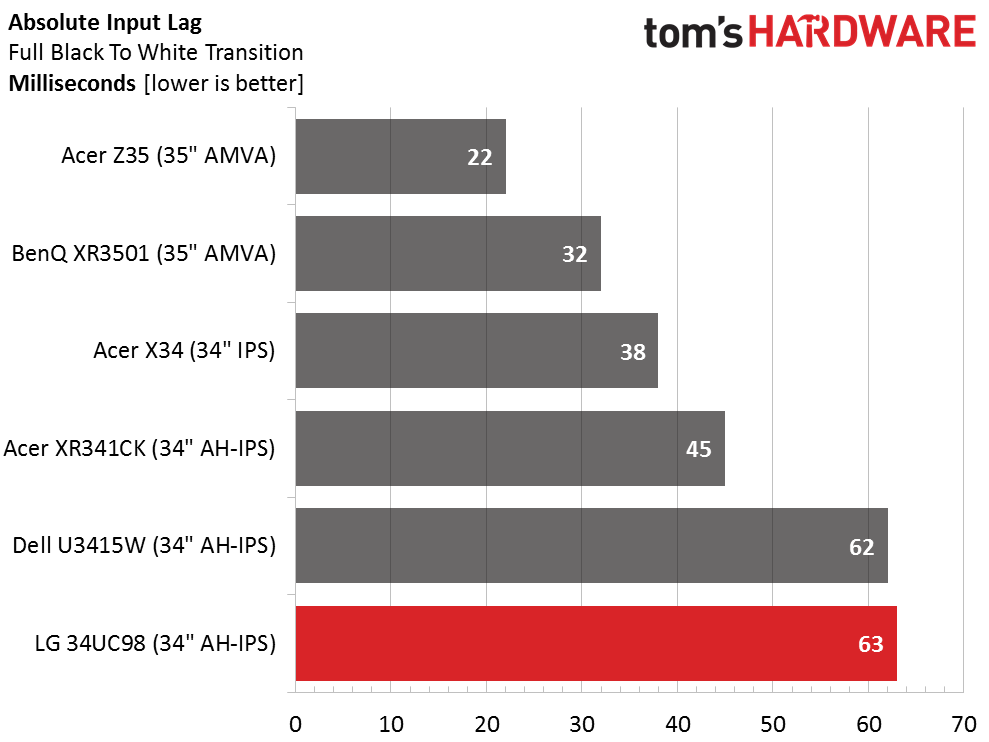LG 34UC98 34-inch Curved FreeSync Monitor Review
Today we're checking out LG's latest curved gaming monitor: the 34UC98. It's an IPS screen with 3440x1440 pixels, FreeSync, a 75Hz max refresh rate and MaxxAudio-tuned speakers.
Why you can trust Tom's Hardware
Viewing Angles, Uniformity, Response And Lag
To learn how we measure screen uniformity, please click here.
Viewing angles are a little harder to judge on curved screens, especially examples with a small radius like the 34UC98's 1900R. In our photos you can see a green shift along with a 50-percent drop in output to the sides. The top view shows a similar drop in brightness but a less severe tint. We think this monitor makes a good choice for multi-screen setups because its tighter curve means a better wrap-around effect for the user.
Screen Uniformity: Luminance
The advantage to slightly elevated black levels is better uniformity at low brightness. Our sample had no light-bleed or glow at its darkest.
Here's the white field measurement.
White field uniformity is equally fine at a low 6.46 percent. We saw no variations in brightness nor did we see a center hotspot.
Screen Uniformity: Color
The color uniformity test showed slight variations on the right side of the screen where we could see a slight red shift. Down the left edge we could also see just a hint of green. None of this was visible in actual content.
Pixel Response And Input Lag
Please click here to read up on our pixel response and input lag testing procedures.
Get Tom's Hardware's best news and in-depth reviews, straight to your inbox.
75Hz means you'll get faster panel response than most 60Hz screens but you won't quite get the snap of a 144Hz display. Of course the video card's actual frame-rates determine the final result but the 34UC98 delivered the expected numbers in this test. We were able to use the highest overdrive setting without any visible ghosting in our gaming titles.
Here are the lag results.
Obvious there's a bit of extra processing overhead compared to the other displays because the 34UC98 has roughly the same lag as the 60Hz Dell U3415W. For most gamers this won't be an issue but hardcore players will want the lower input lag of the top three displays. It wasn't a problem for us though.
Gaming Impressions
We were concerned about the 34UC98's limited FreeSync range but as it turns out, the game you're playing makes a distinct difference in the visual quality of motion processing. We started with Tomb Raider. It's easy to control framerates in this title by simply changing the detail level. As always we're playing on an R9-285 system. On High, the fps count never dropped below 55 so we enjoyed the smoothness of FreeSync and a fast rate that occasionally hit the max of 75fps. Changing to Ultimate detail brought the machine to its knees but it didn't look as bad as one might think.
Playing below 55fps means you'll either have to accept the high input lag of V-Sync or deal with tearing. In both cases, there is plenty of judder especially below 40fps. However, due to the heavy use of organic textures in this particular game, tearing did not distract too badly. It's helped in part by one of the best overdrive implementations we've seen lately. Many monitors will ghost in areas of high contrast when you set OD to maximum but not the 34UC98. Motion blur is minimized almost to the point where you'd think backlight strobing is in play, which of course is not the case. We would happily play this game all day without the extra lag of V-Sync even if we had to accept framerates below 55.
Our experience was a little different in Battlefield 4. Here there are far more vertical lines to highlight tearing and the artifact was inescapable. But again, we had to max out the detail to get the framerate down for our tests. The game looks awesome at a lower setting when play can be maintained at 60-75fps.
So our recommendation is to take stock of what kind of games you plan to play on the 34UC98 before deciding that its small FreeSync range presents a limitation. In our experience, it isn't always a problem. And the fantastic overdrive option really cleans up fast motion to the point where the image looks almost as clean as one aided by backlight strobing. LG has put some thought into the gameplay experience and it shows.
Current page: Viewing Angles, Uniformity, Response And Lag
Prev Page Color Gamut And Performance Next Page Conclusion
Christian Eberle is a Contributing Editor for Tom's Hardware US. He's a veteran reviewer of A/V equipment, specializing in monitors. Christian began his obsession with tech when he built his first PC in 1991, a 286 running DOS 3.0 at a blazing 12MHz. In 2006, he undertook training from the Imaging Science Foundation in video calibration and testing and thus started a passion for precise imaging that persists to this day. He is also a professional musician with a degree from the New England Conservatory as a classical bassoonist which he used to good effect as a performer with the West Point Army Band from 1987 to 2013. He enjoys watching movies and listening to high-end audio in his custom-built home theater and can be seen riding trails near his home on a race-ready ICE VTX recumbent trike. Christian enjoys the endless summer in Florida where he lives with his wife and Chihuahua and plays with orchestras around the state.
-
3ogdy Nice article! There is a big problem though. LG is usually and unfortunately selling FALSE and FAKE advertising. They put unrealistic pictures of their products on the Internet, on the product's web page and even on the product's box itself. I see that, despite reviewing this screen you haven't provided a single picture of this product taken in real life (unlike those LG promotes the product with...cough, fooling its customers into believing the image goes from edge to edge only for them to find out there are thick black edges all around the screen, cough) - with the screen turned on.Reply
Given how the screen looks like, I'm sure they keep promoting this "borderless" bullshit. Next time you review LG monitors, PLEASE take pictures of the screen turned on.
They literally mentioned their bezels were 1.2mm thick. Guess what, they are actually...wait for it... about 950% bigger - 11mm wide in reality.
Have a look for yourself at the results -
darth_adversor Price tag seems excessive for such a small FreeSync range.Reply
What happens if you exceed 75 fps (i.e. you have a high-end video card, or you're playing a graphically less demanding game)? Can't screen tearing also occur when your fps exceed the monitor's refresh rate?
I've had my gaming PC hooked up to an HDTV for the past several years, considering going back to an actual monitor.
Currently, I use a program called DXtory to limit my fps to 60, I've found that to be superior to v-sync, AMD's FRTC, and/or just letting the framerate run wild. I wonder if that would also work with a FreeSync monitor.
Anyway, great review! -
Larry Litmanen I have a Dell U3415W, also 1440P, also has speakers and also Widescreen in 34 inches, rated by Toms as one of the best monitors for 2015..................Costs $650 or so.Reply -
3ogdy Reply18044039 said:I have a Dell U3415W, also 1440P, also has speakers and also Widescreen in 34 inches, rated by Toms as one of the best monitors for 2015..................Costs $650 or so.
I subscribe.
I happen to be the owner of a Dell UltraSharp U2515H and the image quality is exquisite. It's 1440p too, although only 25". My next monitors will definitely be Dell. -
photonboy 55Hz to 75Hz Freesync range?Reply
WTF?
So you get the smooth game advantage ONLY if your frame rate is between 55FPS and 75FPS.
That SUCKS.
It means when you go above or below this value you either have VSYNC ON or VSYNC OFF. So you might get screen tearing every type you drop below 55FPS, but hitting 75FPS might force VSYNC ON so suddenly you have some added lag (a bit more sluggish).
*Far better to just NOT have the feature likely.
If they'd done 30Hz to 75Hz Freesync range then the low-end would have at least been fine as you'd be in asynchronous mode any time you are below 75FPS. In fact, you could just set a CAP near 70FPS and stay in asynchronous mode all the time, but nooooo.
Basically they must have SAVED A BIT OF MONEY by not supporting the ideal 2.5X minimum ratio for asynchronous range (75/30) so they could put the FREESYNC stamp on the monitor.
GSYNC might be more expensive but NONE of their monitors have this problem at least. -
photonboy To Darth_Adversor->Reply
Setting a cap of 60FPS would mean the GPU outputs a max of 60FPS and that is VSYNC OFF so you will get screen tearing though it may not be obvious for some games (it varies).
If it is a Freesync monitor and 60FPS is within the asynchronous range then the game should be smooth because the GPU dictates when the monitor updates so you don't get screen tear or added latency.
If it is a Freesync monitor and the range is less than 2.5X (75/30) you have VSYNC ON or VSYNC OFF (but not Freesync) if you drop below the minimum. If the range was 40Hz to 75Hz then any time you are below 40FPS you might get screen tear (or stutter if VSYNC is forced back ON).
If it's a normal 60Hz monitor then you simply limit the frame rate to one that matches the monitor. Since VSYNC is OFF you don't get the added latency of buffering to synchronize with the next refresh cycle (every 1/60th second), however you also aren't synchronizing when the frame updates either so you will get screen tearing. -
rockstar_7 ReplyNice article! There is a big problem though. LG is usually and unfortunately selling FALSE and FAKE advertising. They put unrealistic pictures of their products on the Internet, on the product's web page and even on the product's box itself. I see that, despite reviewing this screen you haven't provided a single picture of this product taken in real life (unlike those LG promotes the product with...cough, fooling its customers into believing the image goes from edge to edge only for them to find out there are thick black edges all around the screen, cough) - with the screen turned on.
Given how the screen looks like, I'm sure they keep promoting this "borderless" bullshit. Next time you review LG monitors, PLEASE take pictures of the screen turned on.Nice article! There is a big problem though. LG is usually and unfortunately selling FALSE and FAKE advertising. They put unrealistic pictures of their products on the Internet, on the product's web page and even on the product's box itself. I see that, despite reviewing this screen you haven't provided a single picture of this product taken in real life (unlike those LG promotes the product with...cough, fooling its customers into believing the image goes from edge to edge only for them to find out there are thick black edges all around the screen, cough) - with the screen turned on.
Given how the screen looks like, I'm sure they keep promoting this "borderless" bullshit. Next time you review LG monitors, PLEASE take pictures of the screen turned on.
If you have the latest AMD drivers, just turn the Auto Scaling on.
This will fix those black bars that you see thanks to your ignorance.
-
awez Just want to mention that i have the LG 29um67 Ultra wide HD freesync screen and man can i tell you guys it opened a whole new immersive world of gaming for me coming from a 16:9 24" screen. Feels like a cinema experience. Also i found it to be very practical for work.Reply
I'll never go back to 16:9 aspect ratios :)
